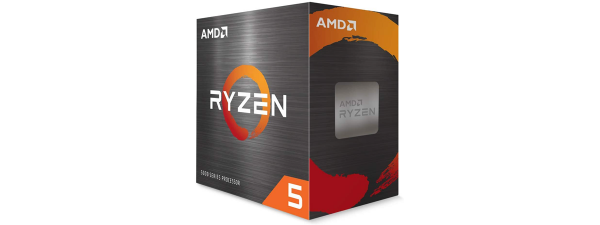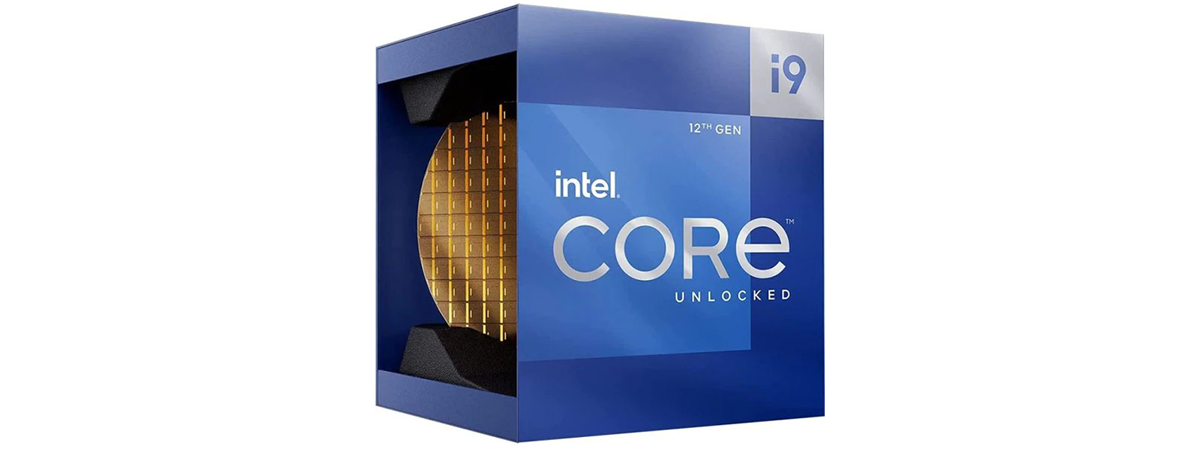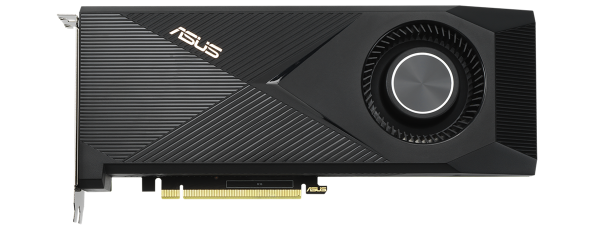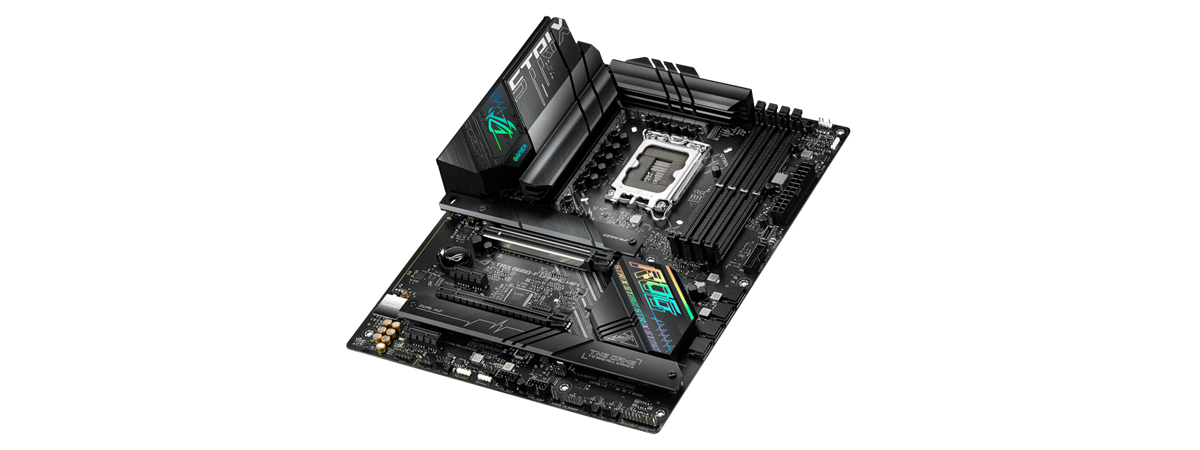
Intel’s Alder Lake architecture is the one that finally brought the company’s processors back in the spotlight. They are now able to compete with AMD’s once again, and people are noticing. Traditionally, Intel’s mid-range processors are the Core i5 models - the ones most of us, at least those who care about price per performance aspect, look for. The latest model, called Intel Core i5-12600K, comes with ten cores and 16 threads and can reach operating speeds of up to 4.9GHz without breaking a sweat. We’ve tested and played with it, and now we’re ready to show you what it can do. Read on and find out whether the Intel Core i5-12600K is the CPU you should buy for your computer:
Intel Core i5-12600K: Who is it good for?
This processor is one of the best choices you can make if:
- You want a CPU with excellent gaming performance
- You’re looking for a powerful processor that can handle anything you throw at it
- You only intend to spend a reasonable amount of money and avoid devices with exorbitant prices
Pros and cons
There are many good things to say about the Intel Core i5-12600K:
- One of the best gaming processors available on the market right now
- 10 cores and 16 threads that offer excellent multi-thread performance
- High-speed achieved in turbo boost speed (4.9 GHz)
- Support for PCI Express 5.0
- Can work with both DDR5 and DDR4 memory
- Reasonable price for a processor of its class
There are also a few downsides:
- Compared to AMD’s alternatives, it’s a power-hungry processor
- Intel doesn’t bundle a cooler with this CPU

Verdict
The Intel Core i5-12600K is THE mainstream desktop processor for gaming at the time of this review. Its scores in benchmarks are excellent, and its performance per price ratio is better than that of its competition. If you are building a new gaming computer right now, the Core i5-12600K processor is an excellent choice. We warmly recommend it to all our readers, as it’s one of the best desktop CPUs on the market.
Unboxing the Intel Core i5-12600K processor
Just like all of Intel’s 12th generation processors, the Intel Core i5-12600K is packaged inside a small blue cardboard box. Its design is simple and only tells you what processor you bought. There aren’t many technical specifications listed, except for the fact that the CPU is unlocked and that it uses the LGA1700 socket.
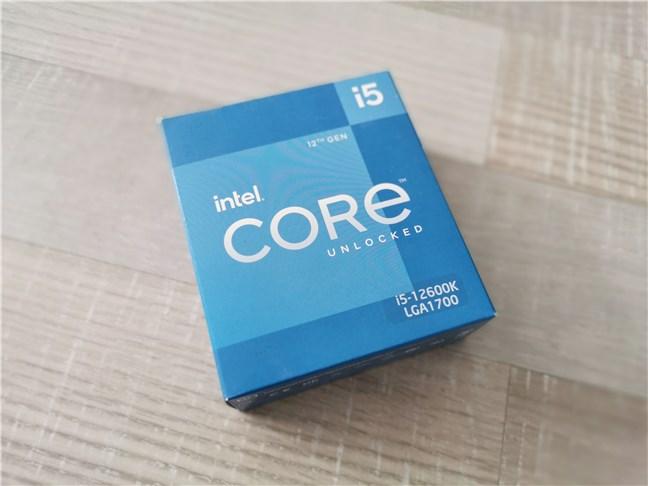
The packaging used for Intel Core i5-12600K
The back of the box is just as simple as the front, but it has a cutout that exposes the actual Intel Core i5-12600K processor. Inside the package, there’s only the processor and a small booklet that contains the installation manual and warranty details.
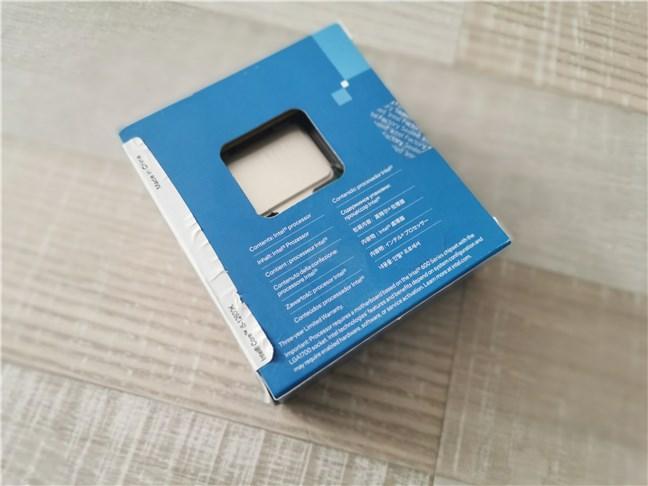
Intel Core i5-12600K: The back of the box
Unboxing the Intel Core i5-12600K processor is quick, as the package contains only the essentials. Unfortunately, the company doesn’t bundle a cooler with this CPU.
Hardware specifications
The Core i5-12600K is Intel’s mid-range option from the Alder Lake family of desktop processors. Its recommended price at launch is 289 ~ 299 USD, although that’s not the one we’ve seen in stores, where it’s listed for about 20 USD more. If you choose to spend your money on the Intel Core i5-12600K, you will get ten cores, 16 threads, 20 MB of Intel Smart Cache, and an integrated Intel UHD Graphics 770 chip.
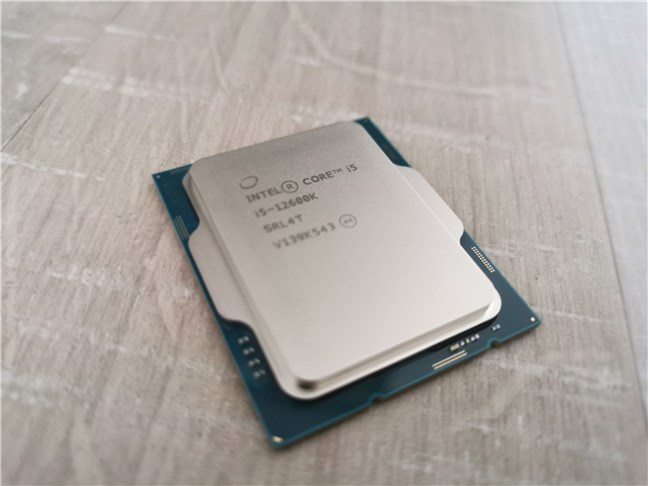
A look at the Intel Core i5-12600K
As it’s built on the Alder Lake architecture, the processor’s cores are not all the same, and some are faster than others. Out of the ten cores, six are performance cores (also named P-cores) that run at a base clock of 3.7 GHz and turbo boost to 4.9 GHz. The other four cores are efficiency cores (or E-cores) that run at a standard frequency of 2.8 GHz and can reach a maximum speed of 3.6 GHz.
The P-cores handle the most demanding tasks, while the E-cores handle the less challenging tasks. Obviously, the performance cores are the ones that do the heavy-lifting in games and taxing applications. Another essential difference between the two sets of cores on 12th generation Intel processors is that the performance cores come with HyperThreading, while efficiency cores don’t. That leads to the unconventional number of threads. On the Intel Core i5-12600K processor that we’re testing today, we get 16 threads because it has 6 P-cores with 2 threads each (so 12 threads total), plus another 4 E-cores each with a single thread.
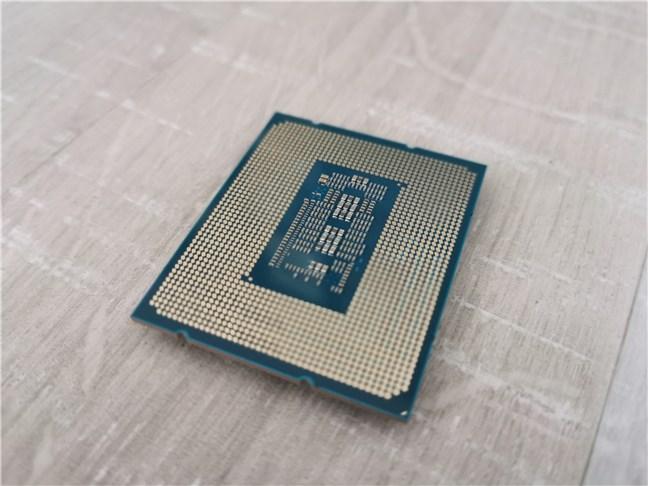
The underside of the Intel Core i5-12600K
The downside, so to speak, is that Intel’s Alder Lake processors need Windows 11 to run at their fullest. So while the Intel Core i5-12600K will run nicely on Windows 10 or Linux, for example, you’ll only get its real power in Windows 11 because, right now, it’s the only operating system that knows how to manage its different (performance and efficiency) cores. For more details, read Windows 11 vs. Windows 10 on 12th Gen Intel Core processors.
In terms of memory, the Intel Core i5-12600K supports up to 128 GB of either DDR4 or DDR5 RAM. You’ll have to choose the right motherboard before you buy the RAM because there are no mainboards on the market that can fit both memory types.
Moving on to PCI Express support, you have to know that the Intel Core i5-12600K supports both revisions 5.0 and 4.0. It has 20 PCIe lanes which can be split between the graphics card (x16) and the NVMe solid-state drive (x4). Alternatively, they could also be used in a configuration of two x8 components plus one x4.
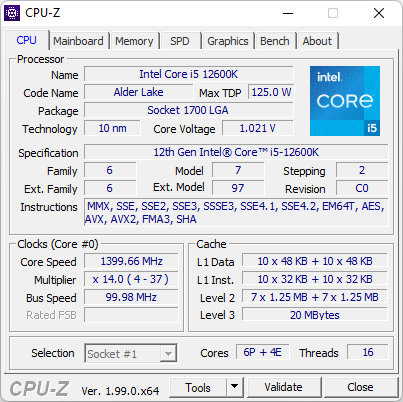
Details about the Intel Core i5-12600K shown by CPU-Z
Finally, a few words about power consumption: Intel abandoned the use of the standard TDP (Thermal Design Power) measurements for its 12th Gen processors, instead providing details about the Processor Base Power and Maximum Turbo Power values. PBP (Processor Base Power) specifies the amount of electrical energy required by the CPU in normal circumstances, while MTP (Maximum Turbo Power) specifies the maximum power requirements of the CPU when running at its highest turbo speed. In the case of Intel Core i5-12600K, the PBP is 125 Watts, and the MTP is 150 Watts.
If you want to check all the technical specifications of the Intel Core i5-12600K, visit its official webpage: Intel Core i5-12600K Product Specifications.
Intel’s Core i5-12600K has excellent specs and an original architecture that make it a strong competitor in the mid-range desktop processors segment. Its maximum turbo speed is just shy of 5 GHz (4.9 GHz), which makes us believe that it’s a great CPU for gaming. Now let’s see what the benchmarks tell us:
Performance in benchmarks and games
We tested the Intel Core i5-12600K processor on a PC with the following hardware and software:
- Motherboard: ASUS ROG STRIX B660-F GAMING WIFI
- Memory: ADATA XPG Lancer DDR5 RAM (2 x 16GB, 5200MHz)
- Graphics Card: ASUS ROG Strix GeForce RTX 3050 8GB
- Storage: ADATA Legend 840 PCIe Gen4 X4 M.2 2280 Solid State Drive
- Power Supply Unit: ASUS ROG Thor 850W Platinum
- Operating System: Windows 11 Pro Version 21H2 Build 22000.527
To get a clearer idea about the performance offered by the Intel Core i5-12600K, we compared it with its more powerful sibling, Intel Core i7-12700K (up to 5.0GHz, 12 cores, and 20 threads). However, one very important aspect is that, for the latter, we had a different hardware configuration when we reviewed it (ASUS ROG Maximus Z690 Extreme, Kingston FURY Beast DDR5 Memory, ASUS TUF Gaming GeForce RTX 3090). The numbers we got in benchmarks are influenced by the different hardware we used, but they should still be good indicators of the performance you get from the i5-12600K versus the i7-12700K.
We started by running CPU-Z to measure the processor's single-thread performance. We got an excellent score of 732 points, not far behind the 792 points achieved by the i7-12700K (which is 8.2% better).
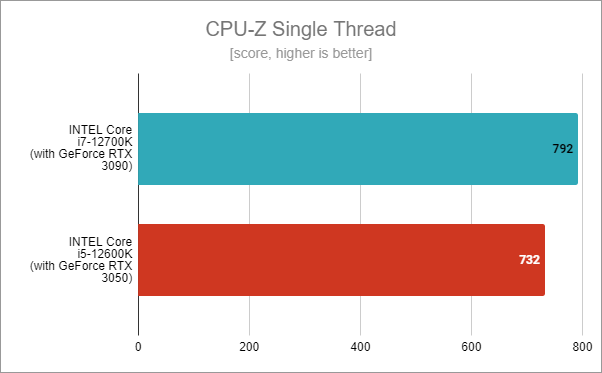
Intel Core i5-12600K benchmark results: CPU-Z Single Thread
In CPU-Z's Multi-Thread benchmark, the Intel Core i5-12600K was able to obtain a score of 7005 points. There are fewer cores available on it compared to the i7-12700K, and it shows: the latter is about 32% better. However, the result is still impressive for its class.
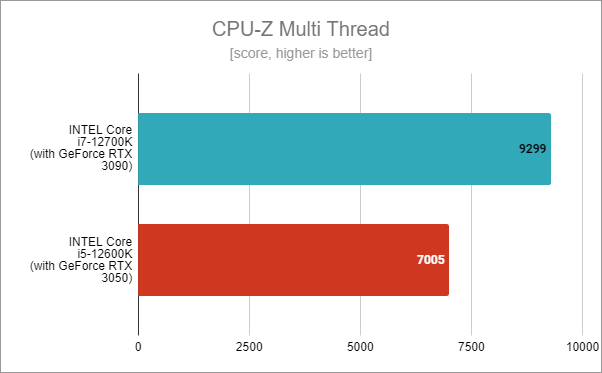
Intel Core i5-12600K benchmark results: CPU-Z Multi Thread
Moving on to the rendering benchmarks, in Cinebench R23, Intel Core i5-12600K managed an all-cores score of 16843 points. It’s an excellent result too (the i7-12700K is 31.3% faster).
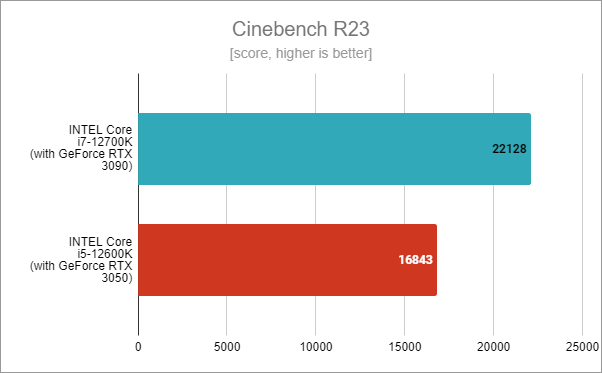
Intel Core i5-12600K benchmark results: Cinebench R23
In Blender, we chose to render the bmw27 and classroom scenes. Here, the shorter the rendering time, the better. The Intel Core i5-12600K needed 9.2 minutes, which is 33.3% more than the 6.9 minutes spent by the i7-12700K in the same jobs. But it’s still an excellent result.
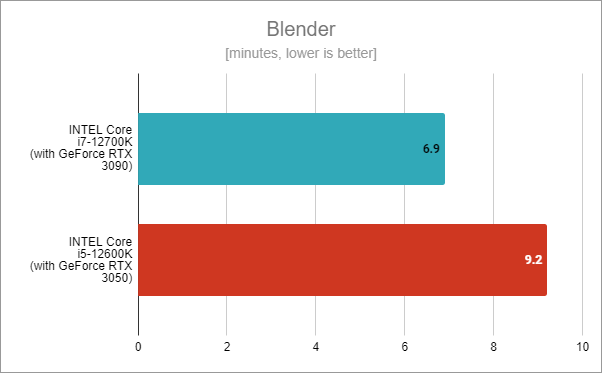
Intel Core i5-12600K benchmark results: Blender
Next came PCMark 10, the go-to software when you need to measure the performance of a computer in common activities such as browsing the web, video conferencing, office work, and creating digital content. With the Intel Core i5-12600K, we got a score of 6970 points, which tells us that any computer equipped with this processor will be very fast in daily tasks.
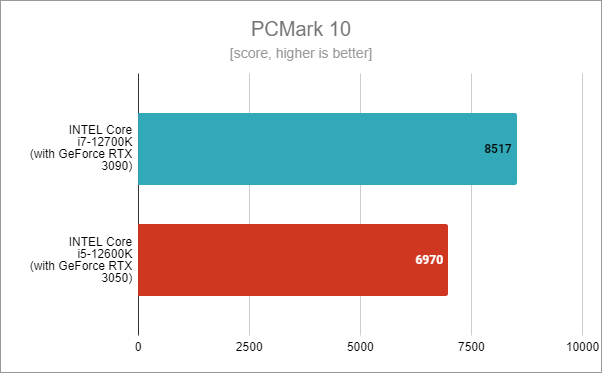
Intel Core i5-12600K benchmark results: PCMark 10
To confirm our previous statement, the Intel Core i5-12600K decided that it should get the same score in the JetStream 2 browser benchmark as the i7-12700K. 🙂 In other words, when web browsing is involved, the tested processor is just as fast as its older brother.
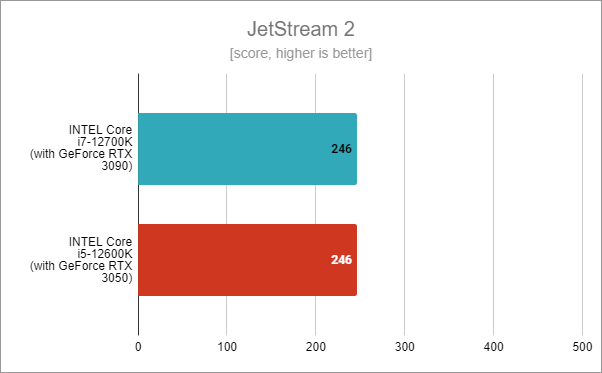
Intel Core i5-12600K benchmark results: JetStream 2
In 7-Zip, the Intel Core i5-12600K achieved a compression rate of 77.5MB/s. It’s slower than the i7-12700K (by 13.9%) but still a very impressive result considering the fewer cores and threads.
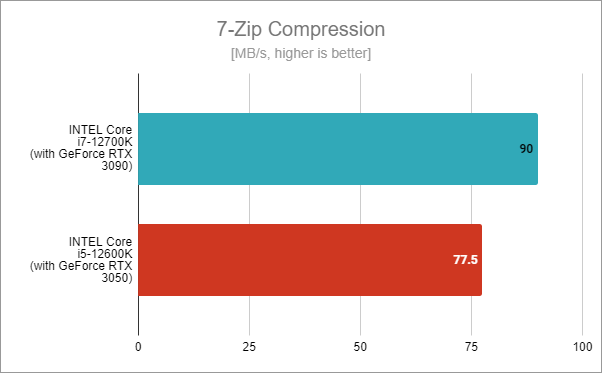
Intel Core i5-12600K benchmark results: 7-Zip Compression
Similarly, the decompression speed measured by 7-Zip was excellent, but not on par with the high-end i7-12700K (which is 19.7% faster).
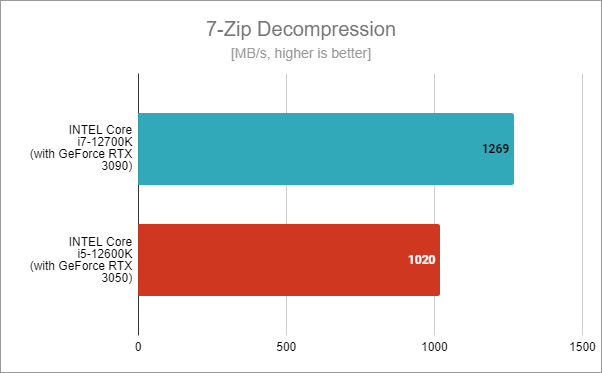
Intel Core i5-12600K benchmark results: 7-Zip Decompression
We continued with a benchmark that evaluates the performance of processors in games: 3DMark CPU Profile. As most games today know how to multi-thread, we compared the all-core results. The Intel Core i5-12600K managed a score of 7962 points. It might look weak against the i7-12700K CPU, but it’s actually a very good result that describes this processor as an excellent choice for gaming.
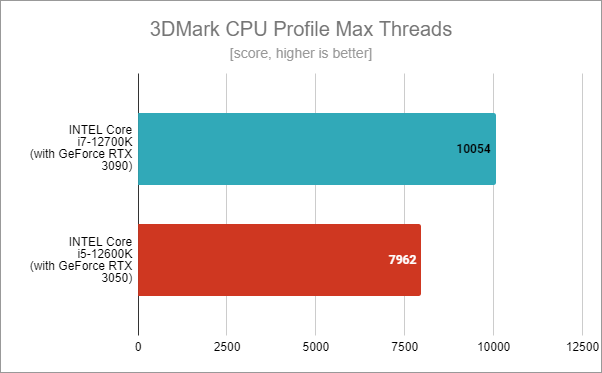
Intel Core i5-12600K benchmark results: 3DMark CPU Profile
NOTE: To avoid GPU bottlenecks as much as possible, for the game benchmarks, we used 1080p resolution and the lowest visual quality settings. However, as we mentioned at the beginning of this section, the results we got are with different hardware components, including the graphics unit. So, take everything from here on with a grain of salt.
In Shadow of the Tomb Raider, using the Intel Core i5-12600K, we measured a framerate of 191 fps. It's not very far behind what we got with the Intel Core i7-12700K.
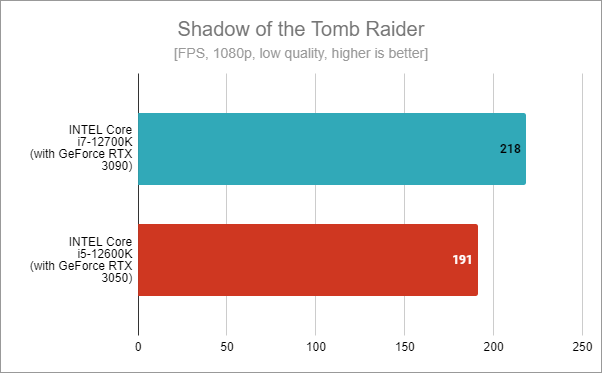
Intel Core i5-12600K benchmark results: Shadow of the Tomb Raider
In Metro Exodus, which is one very power-hungry game, the GeForce RTX 3050 graphics card proved to become a bottleneck for our CPU. Still, we got an excellent result: 165 frames per second.
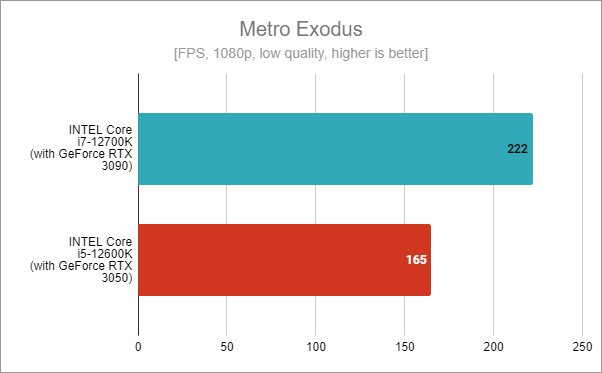
Intel Core i5-12600K benchmark results: Metro Exodus
Similarly, in Assassin's Creed Valhalla, the graphics card didn’t let our Intel Core i5-12600K achieve its full potential, although the result wasn’t bad at all: 117 fps.
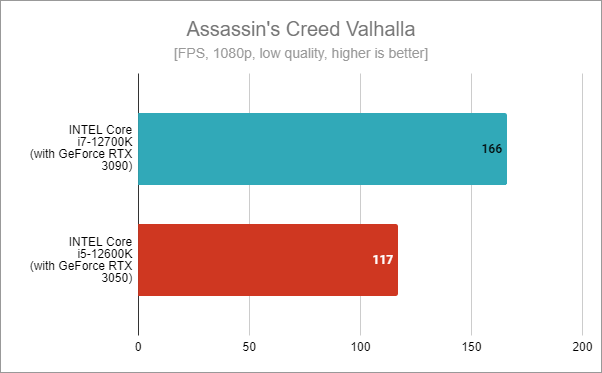
Intel Core i5-12600K benchmark results: Assassin's Creed Valhalla
In order to test the temperatures of the Intel Core i5-12600K, we used AIDA64's stability tests. The maximum temperature we saw was only 65 degrees Celsius (149 degrees Fahrenheit). It's low, and it’s great! 🙂
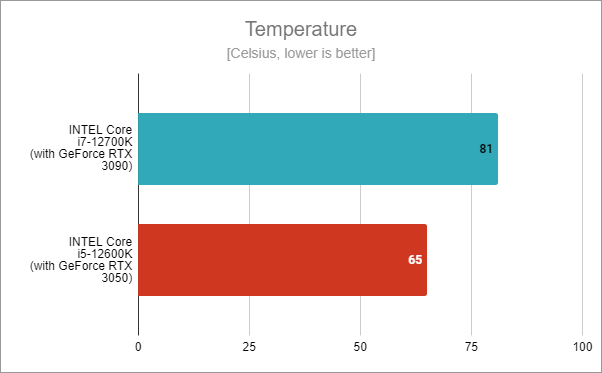
Intel Core i5-12600K temperatures
Finally, we also checked the maximum amount of power required by the Intel Core i5-12600K. On our test platform, it didn’t need more than 116 Watts, which is about 73% of what its big brother, the i7-12700K, requires.
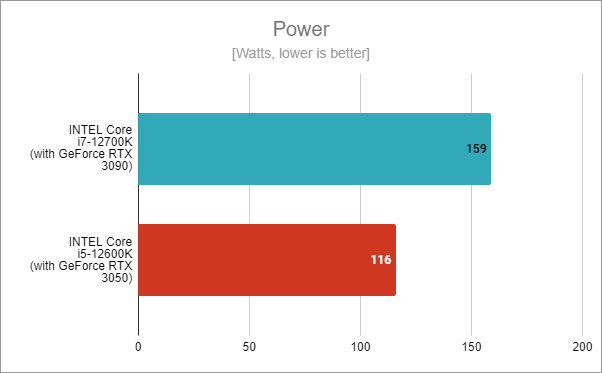
Intel Core i5-12600K power consumption
In our opinion, the Intel Core i5-12600K is one of the best desktop processors you can buy for a reasonable price today. Its gaming performance is excellent, and it easily handles any kind of regular computing activity.
What's your opinion about the Intel Core i5-12600K?
Now you know that the Intel Core i5-12600K is one of the best gaming processors you can get today. As long as you pair it with a powerful graphics card, it can handle any game easily, and you don’t have to break your piggy bank for that. What’s your opinion about it? Do you intend to buy one? Let us know in the comments section below.


 28.02.2022
28.02.2022 